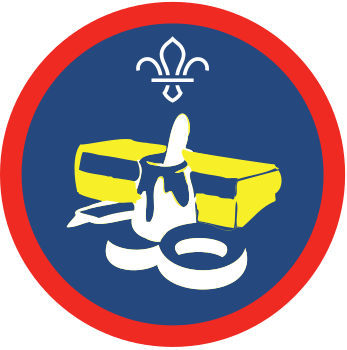
Try craftivism
You’ll need
- Scissors
- Paint
- Coloured pens or pencils
- Glue sticks
- PVA glue
- Rulers
- A4 card
- Tissue paper
- Paint brushes
- Craft materials (for example, tissue paper, pipe cleaners, stickers)
- Copy of the Rosa Parks story and quotes from this activity page
Before you begin
- Use the safety checklist to help you plan and risk assess your activity. Additional help to carry out your risk assessment, including examples can be found here. Don’t forget to make sure all young people and adults involved in the activity know how to take part safely.
- Make sure you’ll have enough adult helpers. You may need some parents and carers to help if you’re short on helpers.
Who's Rosa Parks?
- Gather everyone in a circle.
- Ask if anyone has heard of Rosa Parks and who she is or what she did. Choose a few people to answer if anyone has put their hand up.
- Explain to the group that Rosa Parks was an American activist and member of a civil rights group that fought for black and white people to be treated the same.
- Read out Rosa’s story.
Start your craftivism
- Gather everyone in a group. Tell them that they are going to take part in a form of activism, called Craftivism. You could also decide to do a bigger piece for or in the community to share Rosa’s message, work in pairs or create individual pieces.
- Explain that craftivists, as they are known, aim to make art that provokes thought in a compassionate, gentle and respectful way. The slow, methodical nature of crafting is ideally suited to those who want to make a difference with respect and compassion.
- Read out the Rosa Parks quotes and ask everyone to choose one that inspires them.
- Tell them they’re going to make their chosen quote into a piece of art to display. It could be displayed at your meeting place, at home or at school. Tell everyone where they put their art should allow them to share Rosa Parks’ story and message and allow them to start conversations to others about Rosa Parks, what she did and why.
- Using the craft materials, they should make their piece of art work. They could use and explore lots of different materials or techniques.
- Once everyone’s finished their art, leave it to dry in a safe place. You could let everyone look at and admire each other’s artwork once it’s dry.
- Now, everyone should take their art and display it. Tell everyone to share with you if their art opens any conversations.
In 1950s America, black people were treated very badly just because of the colour of their skin, which is racism. At that time, white people and black people were kept apart by laws in some American states, including Alabama, the state which Rosa Park lived in. Black and white people were segregated in schools, on public transport and in public buildings. However, Rosa Parks’ actions changed American history forever.
On December 1, 1955, Rosa was on a bus in Montgomery, Alabama. As the bus travelled along its regular route, all the white-only seats on the bus filled up. At the next stop, several white passengers boarded. The bus driver noted that two or three white passengers were standing, as the front of the bus had filled. The driver told Rosa to give up her bus seat to a white person, but she said ‘No’. The police were called, Rosa was taken off the bus and arrested.
This started the Montgomery bus boycott, where all black people refused to use the buses. The bus boycott was only meant to last for one day. In the end it lasted over a year and, because of it, the law was changed so that black and white people could sit together. Rosa’s job was sewing and making clothes. She worked in a shop, but after her arrest she lost her job.
Rosa spoke out for civil rights all her life. Dr. Martin Luther King got involved. Alongside Rosa, he campaigned for black people to have the same rights as white people.
- You must never be fearful about what you are doing when it is right
- Each person must live their life as a model for others
- I would like to be remembered as a person who wanted to be free, so other people would also be free
- I knew someone had to take the first step and I made up my mind not to move
- From the time I was a child, I tried to protest against disrespectful treatment
- I believe we are here on the planet Earth to live grow up and do what we can to make this world a better place for all people to enjoy freedom.
- Differences of race, nationality or religion should not be used to deny any human being citizenship rights or privileges.
- The only tired I was, was tired of giving in
- I have learned over the years that when one’s mind is made up, this diminishes the fear; knowing what must be done does away with fear.
- Stand for something or you will fall for anything. Today’s mighty oak is yesterday’s nut that held its ground.
- Whatever my individual desires were to be free, I was not alone. There were many others who felt the same way.
- Each person must live their life as a model for others.
- Racism is still with us. But it is up to us to prepare our children for what they have to meet, and, hopefully, we shall overcome.
- As far back as I can remember, I knew there was something wrong with our way of life when people could be mistreated because of the colour of their skin.
- People always say that I didn't give up my seat because I was tired, but that isn't true. I was not tired physically ... No, the only tired I was, was tired of giving in.
- I was a person with dignity and self-respect, and I should not set my sights lower than anybody else just because I was black.
- Racism is still with us. But it is up to us to prepare our children for what they have to meet, and, hopefully, we shall overcome.
Reflection
Ask everyone why they think Rosa’s work was, and still is, important. Choose a few people to answer.
Tell everyone that lots of people all around the world are still campaigning against racism and discrimination today. Racism is where someone treats another person differently because their skin colour is not the same as theirs, they speak a different language or have different religious beliefs, for example.
All of us at Scouts want our world to be a place of peace and kindness, which means doing our bit to stand up and speak out against racism and being kind to everyone.
Ask everyone how they think we can help learn about, prevent and report racism. Some ideas may include reporting any racism we hear or see; making sure not to judge people on their skin colour, what they wear or their beliefs; and making sure everyone is included and educating ourselves, such as learning about black history.
Safety
All activities must be safely managed. You must complete a thorough risk assessment and take appropriate steps to reduce risk. Use the safety checklist to help you plan and risk assess your activity. Always get approval for the activity, and have suitable supervision and an InTouch process.
- Glue and solvents
Always supervise young people appropriately when they’re using glue and solvent products. Make sure there’s plenty of ventilation. Be aware of any medical conditions that could be affected by glue or solvent use and make adjustments as needed.
- Scissors
Supervise young people appropriately when they’re using scissors. Store all sharp objects securely, out of the reach of young people.
If anyone needs help or struggles with fine motor skills, give them the opportunity to work in pairs, with a young leader or an adult volunteer. Alternatively, swap out the items for something easier to handle, such as larger paintbrushes or easy grip colouring pens.
Anyone who struggles with reading or writing could work with an adult, young leader, or a more confident reader who’s happy to help them work out the beads they need to spell their word. Young people could also use stickers or collage, instead of writing letters and drawing.
You could have print-outs of the quotes for young people to decorate around, too.
All Scout activities should be inclusive and accessible.
You could do some more of our activities to learn about Black History or teach young people about racism. Look at Newsround’s article on what racism is and what can be done about it to talk to young people further about racism.
Young people should be able to create their art however they want to. You could ask a young person or young leader to read out Rosa’s story too.

